IBUS60010 Report: Impact of Low-Cost Labor on Global Economy
VerifiedAdded on 2023/04/22
|9
|2801
|371
Report
AI Summary
This report analyzes the characteristics of global economic cycles driven by low-cost labor factor endowment, particularly focusing on the role of emerging economies. It discusses the influence of factors like capital endowment, labor productivity, technology, and human skills on comparative advantage and global trade patterns. The report further examines whether the economic cycle based on low-cost labor is likely to continue, considering aspects such as technology innovation, rapid industrialization, and the impact of emerging markets on international business from theoretical and empirical perspectives. Institutional theory, transaction costs, resource-based outlook, sampling methods, data collection, and mixed methodologies are also explored in the context of emerging economies.
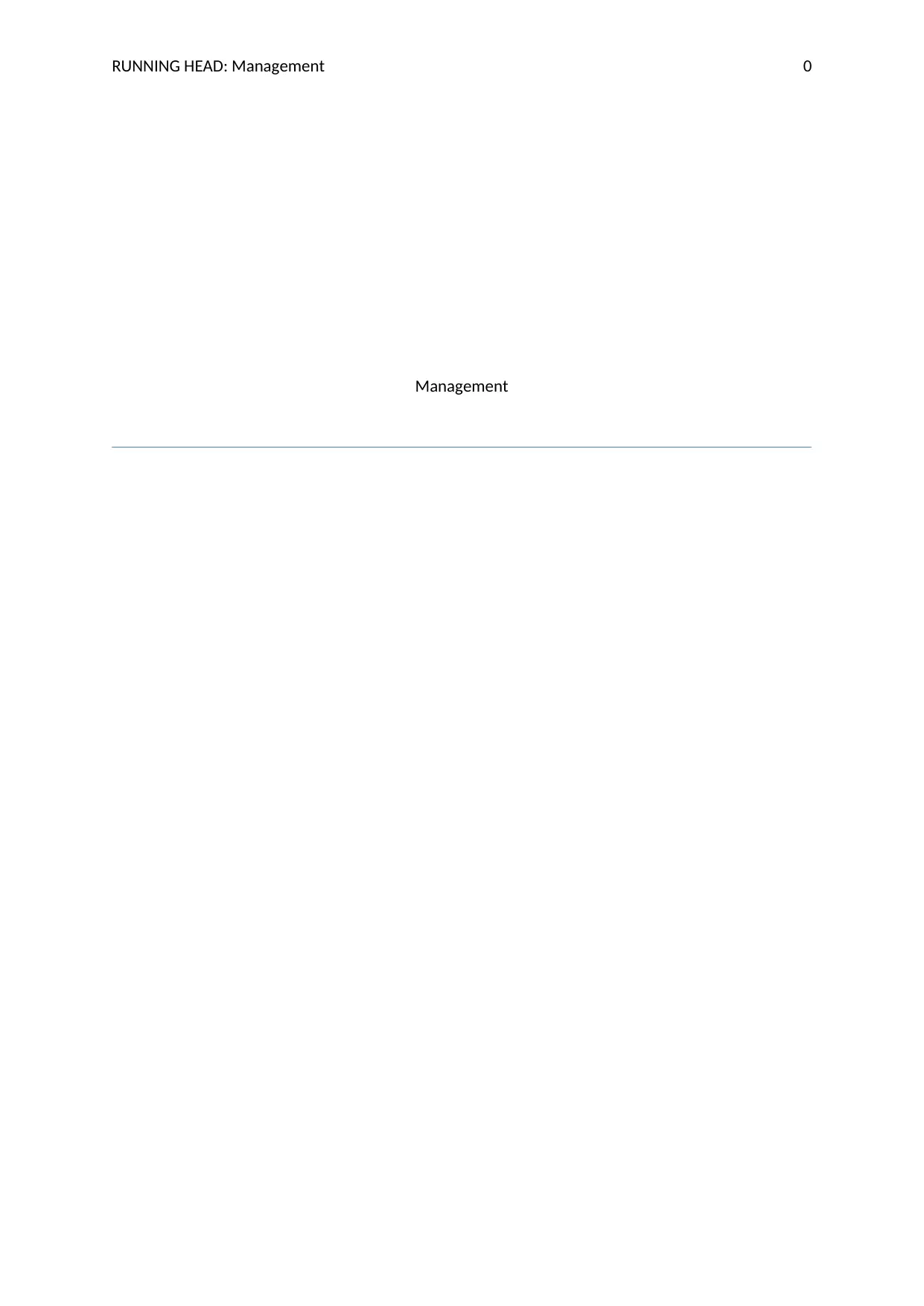
RUNNING HEAD: Management 0
Management
Management
Paraphrase This Document
Need a fresh take? Get an instant paraphrase of this document with our AI Paraphraser
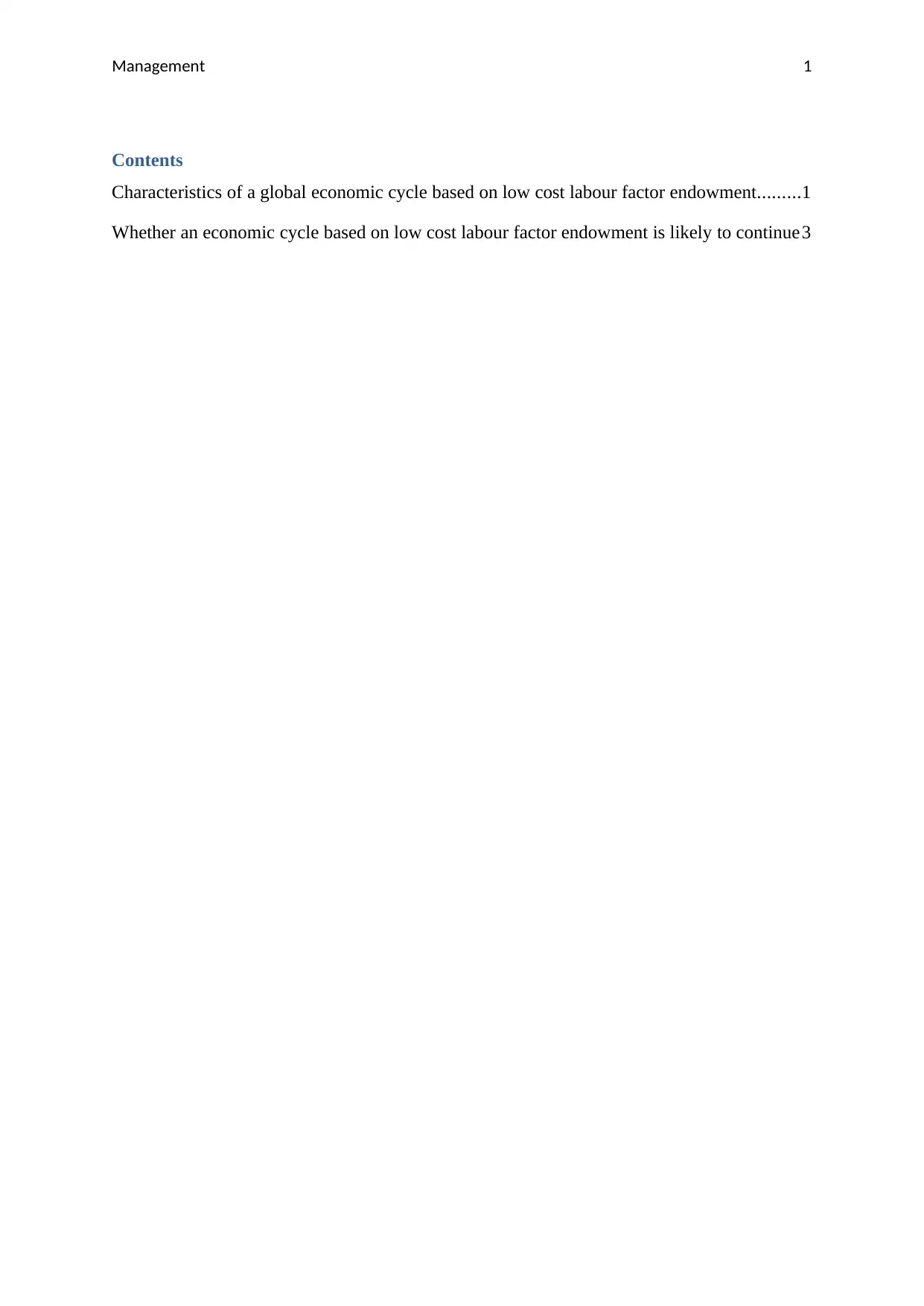
Management 1
Contents
Characteristics of a global economic cycle based on low cost labour factor endowment.........1
Whether an economic cycle based on low cost labour factor endowment is likely to continue3
Contents
Characteristics of a global economic cycle based on low cost labour factor endowment.........1
Whether an economic cycle based on low cost labour factor endowment is likely to continue3
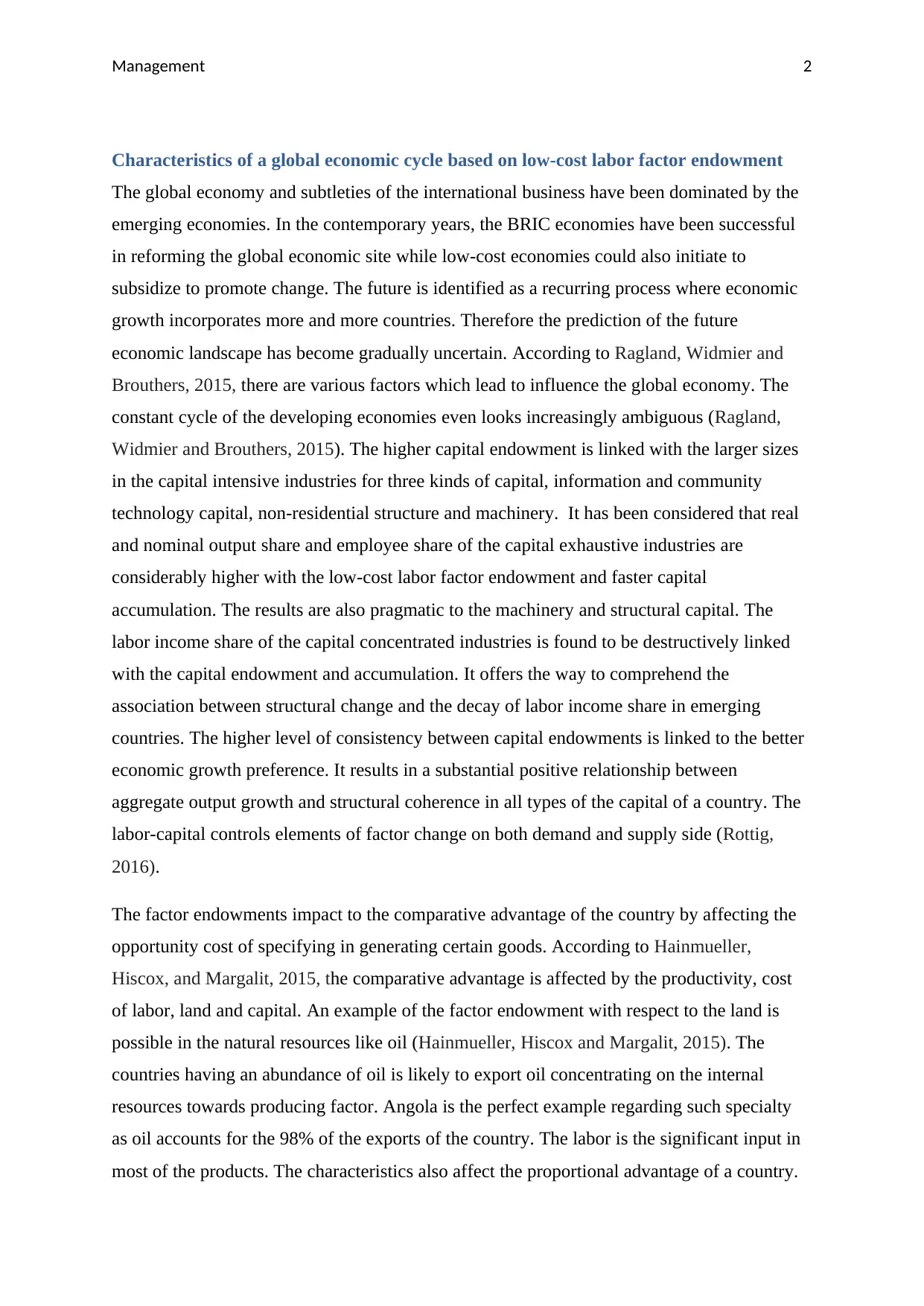
Management 2
Characteristics of a global economic cycle based on low-cost labor factor endowment
The global economy and subtleties of the international business have been dominated by the
emerging economies. In the contemporary years, the BRIC economies have been successful
in reforming the global economic site while low-cost economies could also initiate to
subsidize to promote change. The future is identified as a recurring process where economic
growth incorporates more and more countries. Therefore the prediction of the future
economic landscape has become gradually uncertain. According to Ragland, Widmier and
Brouthers, 2015, there are various factors which lead to influence the global economy. The
constant cycle of the developing economies even looks increasingly ambiguous (Ragland,
Widmier and Brouthers, 2015). The higher capital endowment is linked with the larger sizes
in the capital intensive industries for three kinds of capital, information and community
technology capital, non-residential structure and machinery. It has been considered that real
and nominal output share and employee share of the capital exhaustive industries are
considerably higher with the low-cost labor factor endowment and faster capital
accumulation. The results are also pragmatic to the machinery and structural capital. The
labor income share of the capital concentrated industries is found to be destructively linked
with the capital endowment and accumulation. It offers the way to comprehend the
association between structural change and the decay of labor income share in emerging
countries. The higher level of consistency between capital endowments is linked to the better
economic growth preference. It results in a substantial positive relationship between
aggregate output growth and structural coherence in all types of the capital of a country. The
labor-capital controls elements of factor change on both demand and supply side (Rottig,
2016).
The factor endowments impact to the comparative advantage of the country by affecting the
opportunity cost of specifying in generating certain goods. According to Hainmueller,
Hiscox, and Margalit, 2015, the comparative advantage is affected by the productivity, cost
of labor, land and capital. An example of the factor endowment with respect to the land is
possible in the natural resources like oil (Hainmueller, Hiscox and Margalit, 2015). The
countries having an abundance of oil is likely to export oil concentrating on the internal
resources towards producing factor. Angola is the perfect example regarding such specialty
as oil accounts for the 98% of the exports of the country. The labor is the significant input in
most of the products. The characteristics also affect the proportional advantage of a country.
Characteristics of a global economic cycle based on low-cost labor factor endowment
The global economy and subtleties of the international business have been dominated by the
emerging economies. In the contemporary years, the BRIC economies have been successful
in reforming the global economic site while low-cost economies could also initiate to
subsidize to promote change. The future is identified as a recurring process where economic
growth incorporates more and more countries. Therefore the prediction of the future
economic landscape has become gradually uncertain. According to Ragland, Widmier and
Brouthers, 2015, there are various factors which lead to influence the global economy. The
constant cycle of the developing economies even looks increasingly ambiguous (Ragland,
Widmier and Brouthers, 2015). The higher capital endowment is linked with the larger sizes
in the capital intensive industries for three kinds of capital, information and community
technology capital, non-residential structure and machinery. It has been considered that real
and nominal output share and employee share of the capital exhaustive industries are
considerably higher with the low-cost labor factor endowment and faster capital
accumulation. The results are also pragmatic to the machinery and structural capital. The
labor income share of the capital concentrated industries is found to be destructively linked
with the capital endowment and accumulation. It offers the way to comprehend the
association between structural change and the decay of labor income share in emerging
countries. The higher level of consistency between capital endowments is linked to the better
economic growth preference. It results in a substantial positive relationship between
aggregate output growth and structural coherence in all types of the capital of a country. The
labor-capital controls elements of factor change on both demand and supply side (Rottig,
2016).
The factor endowments impact to the comparative advantage of the country by affecting the
opportunity cost of specifying in generating certain goods. According to Hainmueller,
Hiscox, and Margalit, 2015, the comparative advantage is affected by the productivity, cost
of labor, land and capital. An example of the factor endowment with respect to the land is
possible in the natural resources like oil (Hainmueller, Hiscox and Margalit, 2015). The
countries having an abundance of oil is likely to export oil concentrating on the internal
resources towards producing factor. Angola is the perfect example regarding such specialty
as oil accounts for the 98% of the exports of the country. The labor is the significant input in
most of the products. The characteristics also affect the proportional advantage of a country.
⊘ This is a preview!⊘
Do you want full access?
Subscribe today to unlock all pages.

Trusted by 1+ million students worldwide
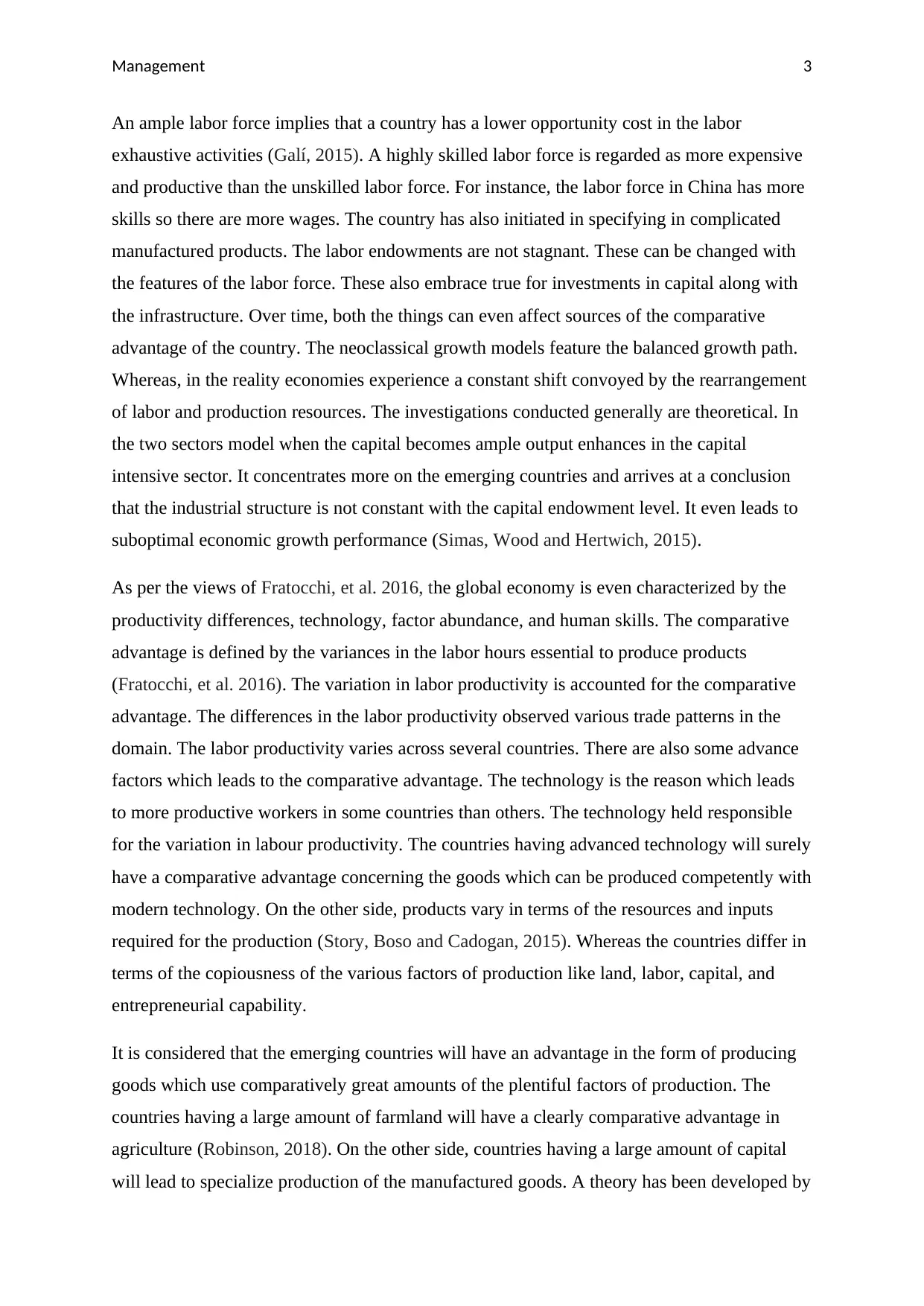
Management 3
An ample labor force implies that a country has a lower opportunity cost in the labor
exhaustive activities (Galí, 2015). A highly skilled labor force is regarded as more expensive
and productive than the unskilled labor force. For instance, the labor force in China has more
skills so there are more wages. The country has also initiated in specifying in complicated
manufactured products. The labor endowments are not stagnant. These can be changed with
the features of the labor force. These also embrace true for investments in capital along with
the infrastructure. Over time, both the things can even affect sources of the comparative
advantage of the country. The neoclassical growth models feature the balanced growth path.
Whereas, in the reality economies experience a constant shift convoyed by the rearrangement
of labor and production resources. The investigations conducted generally are theoretical. In
the two sectors model when the capital becomes ample output enhances in the capital
intensive sector. It concentrates more on the emerging countries and arrives at a conclusion
that the industrial structure is not constant with the capital endowment level. It even leads to
suboptimal economic growth performance (Simas, Wood and Hertwich, 2015).
As per the views of Fratocchi, et al. 2016, the global economy is even characterized by the
productivity differences, technology, factor abundance, and human skills. The comparative
advantage is defined by the variances in the labor hours essential to produce products
(Fratocchi, et al. 2016). The variation in labor productivity is accounted for the comparative
advantage. The differences in the labor productivity observed various trade patterns in the
domain. The labor productivity varies across several countries. There are also some advance
factors which leads to the comparative advantage. The technology is the reason which leads
to more productive workers in some countries than others. The technology held responsible
for the variation in labour productivity. The countries having advanced technology will surely
have a comparative advantage concerning the goods which can be produced competently with
modern technology. On the other side, products vary in terms of the resources and inputs
required for the production (Story, Boso and Cadogan, 2015). Whereas the countries differ in
terms of the copiousness of the various factors of production like land, labor, capital, and
entrepreneurial capability.
It is considered that the emerging countries will have an advantage in the form of producing
goods which use comparatively great amounts of the plentiful factors of production. The
countries having a large amount of farmland will have a clearly comparative advantage in
agriculture (Robinson, 2018). On the other side, countries having a large amount of capital
will lead to specialize production of the manufactured goods. A theory has been developed by
An ample labor force implies that a country has a lower opportunity cost in the labor
exhaustive activities (Galí, 2015). A highly skilled labor force is regarded as more expensive
and productive than the unskilled labor force. For instance, the labor force in China has more
skills so there are more wages. The country has also initiated in specifying in complicated
manufactured products. The labor endowments are not stagnant. These can be changed with
the features of the labor force. These also embrace true for investments in capital along with
the infrastructure. Over time, both the things can even affect sources of the comparative
advantage of the country. The neoclassical growth models feature the balanced growth path.
Whereas, in the reality economies experience a constant shift convoyed by the rearrangement
of labor and production resources. The investigations conducted generally are theoretical. In
the two sectors model when the capital becomes ample output enhances in the capital
intensive sector. It concentrates more on the emerging countries and arrives at a conclusion
that the industrial structure is not constant with the capital endowment level. It even leads to
suboptimal economic growth performance (Simas, Wood and Hertwich, 2015).
As per the views of Fratocchi, et al. 2016, the global economy is even characterized by the
productivity differences, technology, factor abundance, and human skills. The comparative
advantage is defined by the variances in the labor hours essential to produce products
(Fratocchi, et al. 2016). The variation in labor productivity is accounted for the comparative
advantage. The differences in the labor productivity observed various trade patterns in the
domain. The labor productivity varies across several countries. There are also some advance
factors which leads to the comparative advantage. The technology is the reason which leads
to more productive workers in some countries than others. The technology held responsible
for the variation in labour productivity. The countries having advanced technology will surely
have a comparative advantage concerning the goods which can be produced competently with
modern technology. On the other side, products vary in terms of the resources and inputs
required for the production (Story, Boso and Cadogan, 2015). Whereas the countries differ in
terms of the copiousness of the various factors of production like land, labor, capital, and
entrepreneurial capability.
It is considered that the emerging countries will have an advantage in the form of producing
goods which use comparatively great amounts of the plentiful factors of production. The
countries having a large amount of farmland will have a clearly comparative advantage in
agriculture (Robinson, 2018). On the other side, countries having a large amount of capital
will lead to specialize production of the manufactured goods. A theory has been developed by
Paraphrase This Document
Need a fresh take? Get an instant paraphrase of this document with our AI Paraphraser
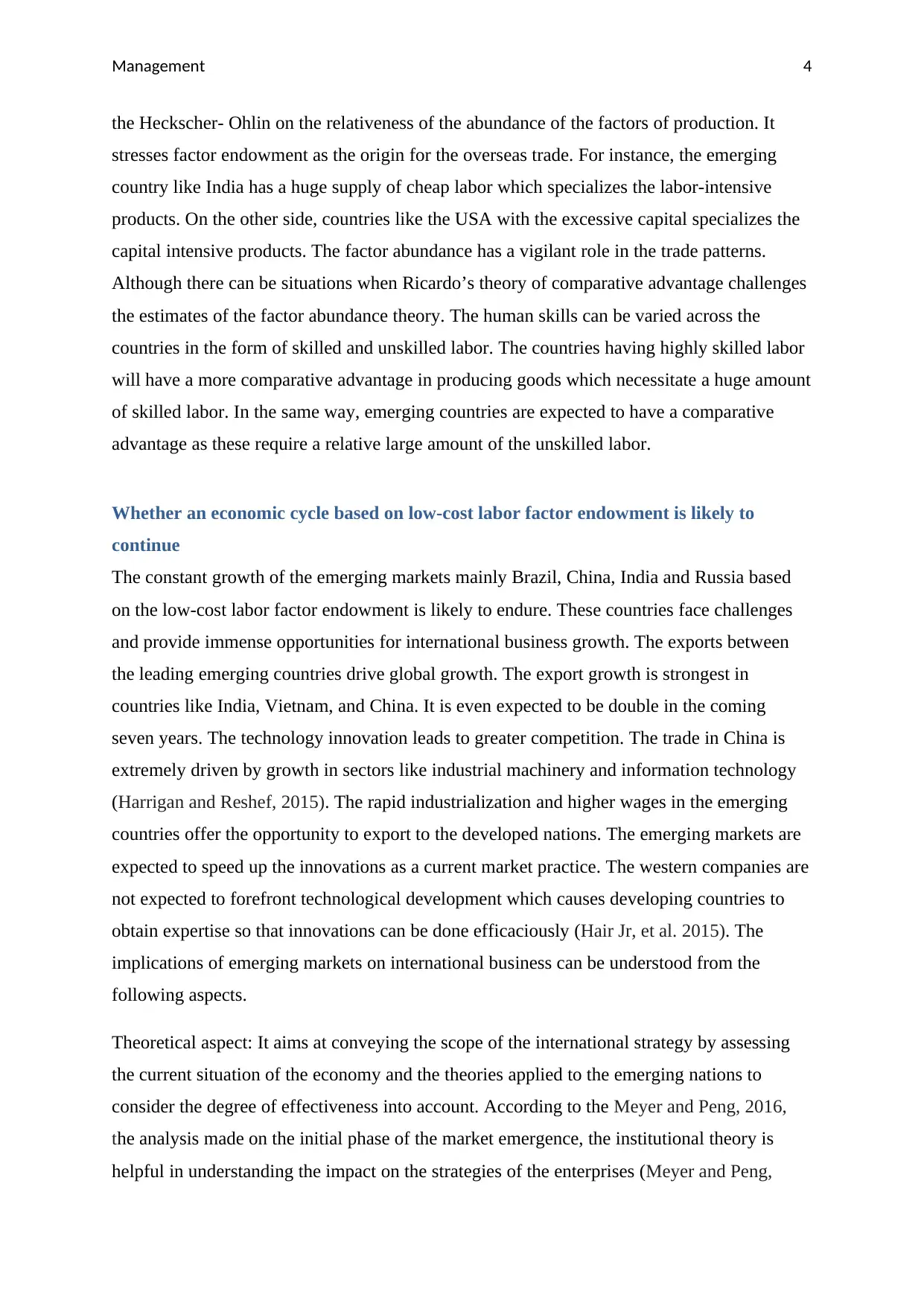
Management 4
the Heckscher- Ohlin on the relativeness of the abundance of the factors of production. It
stresses factor endowment as the origin for the overseas trade. For instance, the emerging
country like India has a huge supply of cheap labor which specializes the labor-intensive
products. On the other side, countries like the USA with the excessive capital specializes the
capital intensive products. The factor abundance has a vigilant role in the trade patterns.
Although there can be situations when Ricardo’s theory of comparative advantage challenges
the estimates of the factor abundance theory. The human skills can be varied across the
countries in the form of skilled and unskilled labor. The countries having highly skilled labor
will have a more comparative advantage in producing goods which necessitate a huge amount
of skilled labor. In the same way, emerging countries are expected to have a comparative
advantage as these require a relative large amount of the unskilled labor.
Whether an economic cycle based on low-cost labor factor endowment is likely to
continue
The constant growth of the emerging markets mainly Brazil, China, India and Russia based
on the low-cost labor factor endowment is likely to endure. These countries face challenges
and provide immense opportunities for international business growth. The exports between
the leading emerging countries drive global growth. The export growth is strongest in
countries like India, Vietnam, and China. It is even expected to be double in the coming
seven years. The technology innovation leads to greater competition. The trade in China is
extremely driven by growth in sectors like industrial machinery and information technology
(Harrigan and Reshef, 2015). The rapid industrialization and higher wages in the emerging
countries offer the opportunity to export to the developed nations. The emerging markets are
expected to speed up the innovations as a current market practice. The western companies are
not expected to forefront technological development which causes developing countries to
obtain expertise so that innovations can be done efficaciously (Hair Jr, et al. 2015). The
implications of emerging markets on international business can be understood from the
following aspects.
Theoretical aspect: It aims at conveying the scope of the international strategy by assessing
the current situation of the economy and the theories applied to the emerging nations to
consider the degree of effectiveness into account. According to the Meyer and Peng, 2016,
the analysis made on the initial phase of the market emergence, the institutional theory is
helpful in understanding the impact on the strategies of the enterprises (Meyer and Peng,
the Heckscher- Ohlin on the relativeness of the abundance of the factors of production. It
stresses factor endowment as the origin for the overseas trade. For instance, the emerging
country like India has a huge supply of cheap labor which specializes the labor-intensive
products. On the other side, countries like the USA with the excessive capital specializes the
capital intensive products. The factor abundance has a vigilant role in the trade patterns.
Although there can be situations when Ricardo’s theory of comparative advantage challenges
the estimates of the factor abundance theory. The human skills can be varied across the
countries in the form of skilled and unskilled labor. The countries having highly skilled labor
will have a more comparative advantage in producing goods which necessitate a huge amount
of skilled labor. In the same way, emerging countries are expected to have a comparative
advantage as these require a relative large amount of the unskilled labor.
Whether an economic cycle based on low-cost labor factor endowment is likely to
continue
The constant growth of the emerging markets mainly Brazil, China, India and Russia based
on the low-cost labor factor endowment is likely to endure. These countries face challenges
and provide immense opportunities for international business growth. The exports between
the leading emerging countries drive global growth. The export growth is strongest in
countries like India, Vietnam, and China. It is even expected to be double in the coming
seven years. The technology innovation leads to greater competition. The trade in China is
extremely driven by growth in sectors like industrial machinery and information technology
(Harrigan and Reshef, 2015). The rapid industrialization and higher wages in the emerging
countries offer the opportunity to export to the developed nations. The emerging markets are
expected to speed up the innovations as a current market practice. The western companies are
not expected to forefront technological development which causes developing countries to
obtain expertise so that innovations can be done efficaciously (Hair Jr, et al. 2015). The
implications of emerging markets on international business can be understood from the
following aspects.
Theoretical aspect: It aims at conveying the scope of the international strategy by assessing
the current situation of the economy and the theories applied to the emerging nations to
consider the degree of effectiveness into account. According to the Meyer and Peng, 2016,
the analysis made on the initial phase of the market emergence, the institutional theory is
helpful in understanding the impact on the strategies of the enterprises (Meyer and Peng,
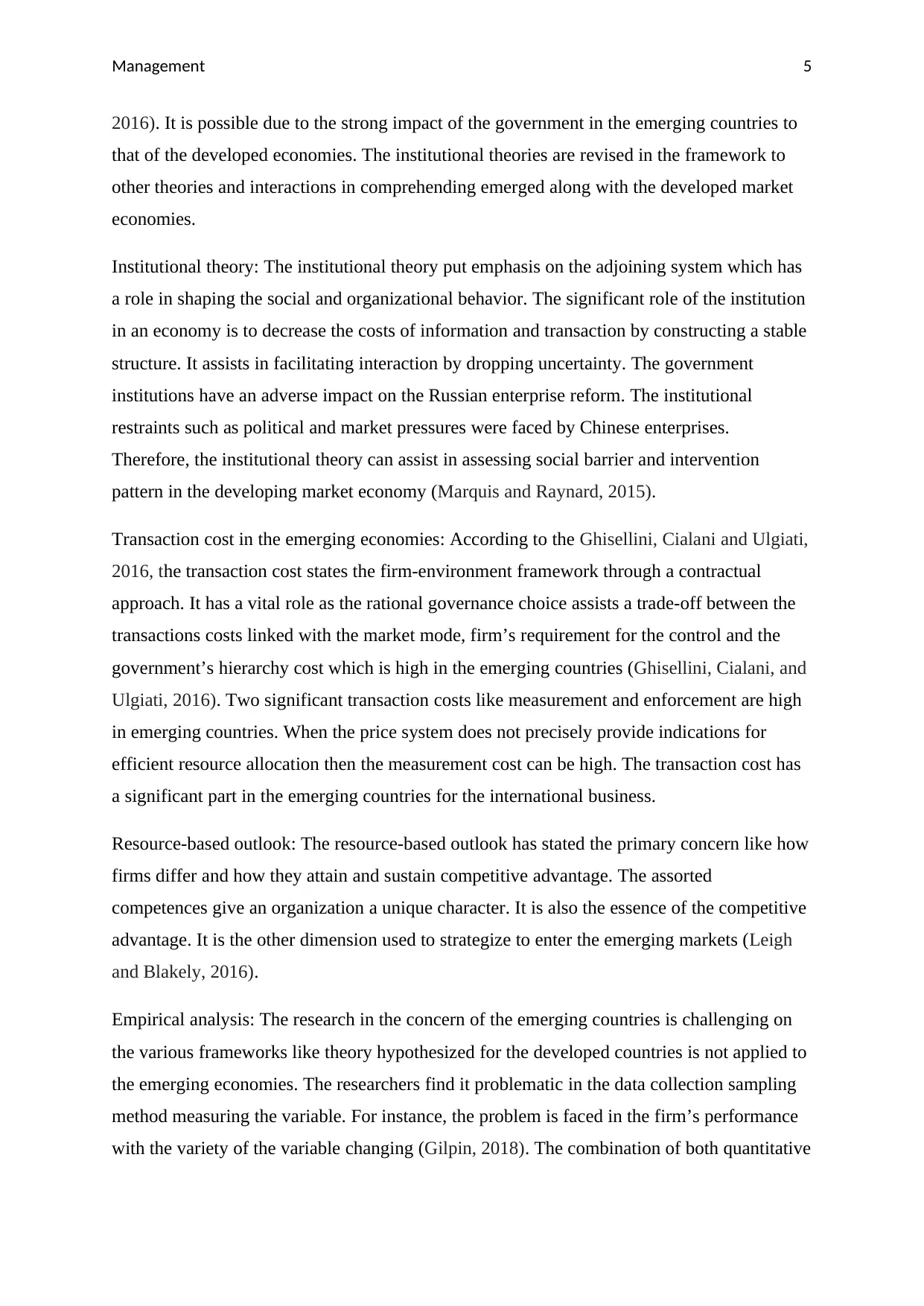
Management 5
2016). It is possible due to the strong impact of the government in the emerging countries to
that of the developed economies. The institutional theories are revised in the framework to
other theories and interactions in comprehending emerged along with the developed market
economies.
Institutional theory: The institutional theory put emphasis on the adjoining system which has
a role in shaping the social and organizational behavior. The significant role of the institution
in an economy is to decrease the costs of information and transaction by constructing a stable
structure. It assists in facilitating interaction by dropping uncertainty. The government
institutions have an adverse impact on the Russian enterprise reform. The institutional
restraints such as political and market pressures were faced by Chinese enterprises.
Therefore, the institutional theory can assist in assessing social barrier and intervention
pattern in the developing market economy (Marquis and Raynard, 2015).
Transaction cost in the emerging economies: According to the Ghisellini, Cialani and Ulgiati,
2016, the transaction cost states the firm-environment framework through a contractual
approach. It has a vital role as the rational governance choice assists a trade-off between the
transactions costs linked with the market mode, firm’s requirement for the control and the
government’s hierarchy cost which is high in the emerging countries (Ghisellini, Cialani, and
Ulgiati, 2016). Two significant transaction costs like measurement and enforcement are high
in emerging countries. When the price system does not precisely provide indications for
efficient resource allocation then the measurement cost can be high. The transaction cost has
a significant part in the emerging countries for the international business.
Resource-based outlook: The resource-based outlook has stated the primary concern like how
firms differ and how they attain and sustain competitive advantage. The assorted
competences give an organization a unique character. It is also the essence of the competitive
advantage. It is the other dimension used to strategize to enter the emerging markets (Leigh
and Blakely, 2016).
Empirical analysis: The research in the concern of the emerging countries is challenging on
the various frameworks like theory hypothesized for the developed countries is not applied to
the emerging economies. The researchers find it problematic in the data collection sampling
method measuring the variable. For instance, the problem is faced in the firm’s performance
with the variety of the variable changing (Gilpin, 2018). The combination of both quantitative
2016). It is possible due to the strong impact of the government in the emerging countries to
that of the developed economies. The institutional theories are revised in the framework to
other theories and interactions in comprehending emerged along with the developed market
economies.
Institutional theory: The institutional theory put emphasis on the adjoining system which has
a role in shaping the social and organizational behavior. The significant role of the institution
in an economy is to decrease the costs of information and transaction by constructing a stable
structure. It assists in facilitating interaction by dropping uncertainty. The government
institutions have an adverse impact on the Russian enterprise reform. The institutional
restraints such as political and market pressures were faced by Chinese enterprises.
Therefore, the institutional theory can assist in assessing social barrier and intervention
pattern in the developing market economy (Marquis and Raynard, 2015).
Transaction cost in the emerging economies: According to the Ghisellini, Cialani and Ulgiati,
2016, the transaction cost states the firm-environment framework through a contractual
approach. It has a vital role as the rational governance choice assists a trade-off between the
transactions costs linked with the market mode, firm’s requirement for the control and the
government’s hierarchy cost which is high in the emerging countries (Ghisellini, Cialani, and
Ulgiati, 2016). Two significant transaction costs like measurement and enforcement are high
in emerging countries. When the price system does not precisely provide indications for
efficient resource allocation then the measurement cost can be high. The transaction cost has
a significant part in the emerging countries for the international business.
Resource-based outlook: The resource-based outlook has stated the primary concern like how
firms differ and how they attain and sustain competitive advantage. The assorted
competences give an organization a unique character. It is also the essence of the competitive
advantage. It is the other dimension used to strategize to enter the emerging markets (Leigh
and Blakely, 2016).
Empirical analysis: The research in the concern of the emerging countries is challenging on
the various frameworks like theory hypothesized for the developed countries is not applied to
the emerging economies. The researchers find it problematic in the data collection sampling
method measuring the variable. For instance, the problem is faced in the firm’s performance
with the variety of the variable changing (Gilpin, 2018). The combination of both quantitative
⊘ This is a preview!⊘
Do you want full access?
Subscribe today to unlock all pages.

Trusted by 1+ million students worldwide
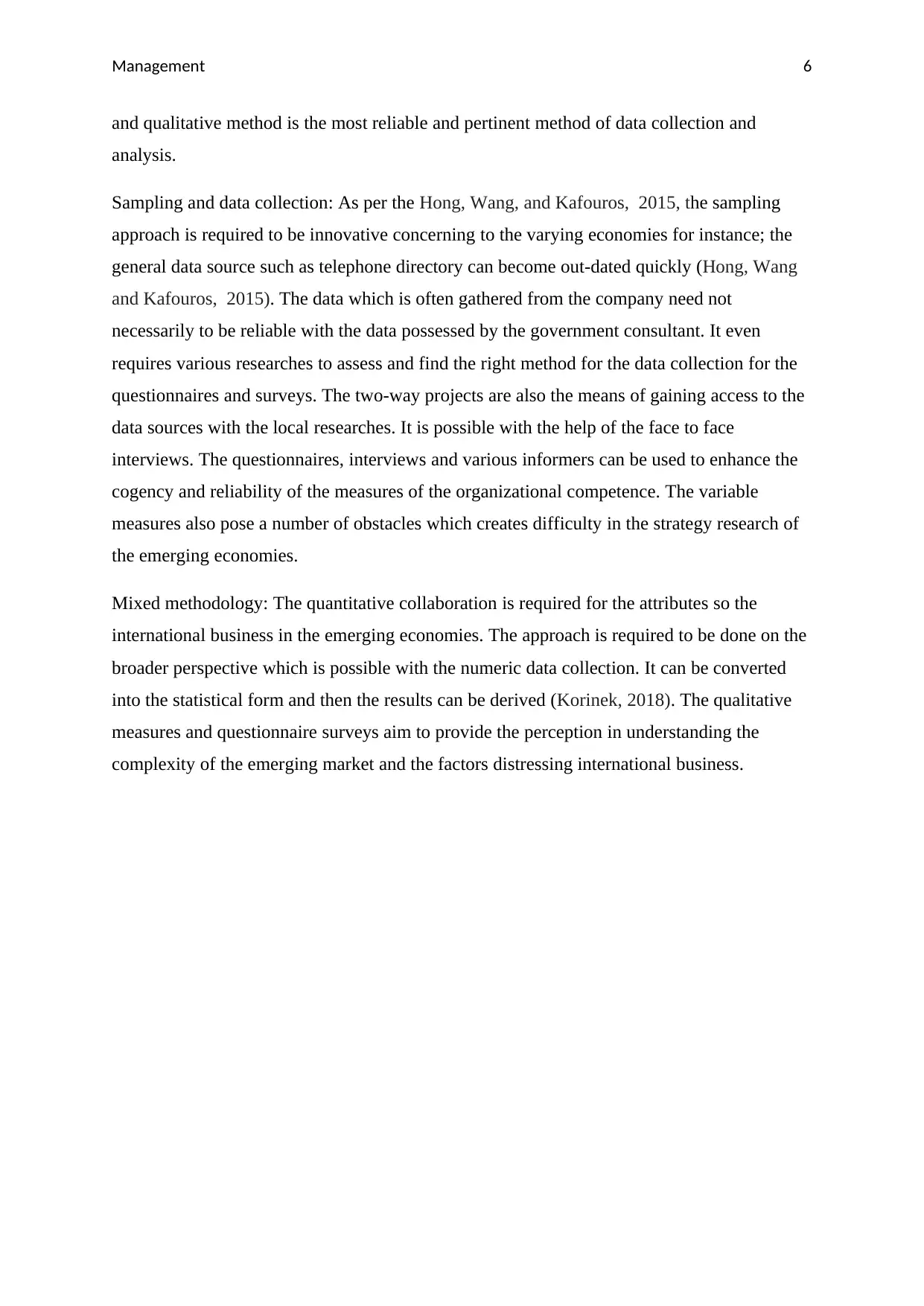
Management 6
and qualitative method is the most reliable and pertinent method of data collection and
analysis.
Sampling and data collection: As per the Hong, Wang, and Kafouros, 2015, the sampling
approach is required to be innovative concerning to the varying economies for instance; the
general data source such as telephone directory can become out-dated quickly (Hong, Wang
and Kafouros, 2015). The data which is often gathered from the company need not
necessarily to be reliable with the data possessed by the government consultant. It even
requires various researches to assess and find the right method for the data collection for the
questionnaires and surveys. The two-way projects are also the means of gaining access to the
data sources with the local researches. It is possible with the help of the face to face
interviews. The questionnaires, interviews and various informers can be used to enhance the
cogency and reliability of the measures of the organizational competence. The variable
measures also pose a number of obstacles which creates difficulty in the strategy research of
the emerging economies.
Mixed methodology: The quantitative collaboration is required for the attributes so the
international business in the emerging economies. The approach is required to be done on the
broader perspective which is possible with the numeric data collection. It can be converted
into the statistical form and then the results can be derived (Korinek, 2018). The qualitative
measures and questionnaire surveys aim to provide the perception in understanding the
complexity of the emerging market and the factors distressing international business.
and qualitative method is the most reliable and pertinent method of data collection and
analysis.
Sampling and data collection: As per the Hong, Wang, and Kafouros, 2015, the sampling
approach is required to be innovative concerning to the varying economies for instance; the
general data source such as telephone directory can become out-dated quickly (Hong, Wang
and Kafouros, 2015). The data which is often gathered from the company need not
necessarily to be reliable with the data possessed by the government consultant. It even
requires various researches to assess and find the right method for the data collection for the
questionnaires and surveys. The two-way projects are also the means of gaining access to the
data sources with the local researches. It is possible with the help of the face to face
interviews. The questionnaires, interviews and various informers can be used to enhance the
cogency and reliability of the measures of the organizational competence. The variable
measures also pose a number of obstacles which creates difficulty in the strategy research of
the emerging economies.
Mixed methodology: The quantitative collaboration is required for the attributes so the
international business in the emerging economies. The approach is required to be done on the
broader perspective which is possible with the numeric data collection. It can be converted
into the statistical form and then the results can be derived (Korinek, 2018). The qualitative
measures and questionnaire surveys aim to provide the perception in understanding the
complexity of the emerging market and the factors distressing international business.
Paraphrase This Document
Need a fresh take? Get an instant paraphrase of this document with our AI Paraphraser

Management 7
References
Fratocchi, L., Ancarani, A., Barbieri, P., Di Mauro, C., Nassimbeni, G., Sartor, M., Vignoli,
M. and Zanoni, A., 2016. Motivations of manufacturing reshoring: an interpretative
framework. International Journal of Physical Distribution & Logistics Management, 46(2),
pp.98-127.
Galí, J., 2015. Monetary policy, inflation, and the business cycle: an introduction to the new
Keynesian framework and its applications. Princeton University Press.
Ghisellini, P., Cialani, C. and Ulgiati, S., 2016. A review on circular economy: the expected
transition to a balanced interplay of environmental and economic systems. Journal of Cleaner
production, 114, pp.11-32.
Gilpin, R., 2018. The challenge of global capitalism: The world economy in the 21st century.
Princeton University Press.
Hainmueller, J., Hiscox, M.J. and Margalit, Y., 2015. Do concerns about labor market
competition shape attitudes toward immigration? New evidence. Journal of International
Economics, 97(1), pp.193-207.
Hair Jr, J.F., Wolfinbarger, M., Money, A.H., Samouel, P. and Page, M.J., 2015. Essentials of
business research methods. Routledge.
Harrigan, J. and Reshef, A., 2015. Skill‐biased heterogeneous firms, trade liberalization and
the skill premium. Canadian Journal of Economics/Revue canadienne d'économique, 48(3),
pp.1024-1066.
Hong, J., Wang, C. and Kafouros, M., 2015. The role of the state in explaining the
internationalization of emerging market enterprises. British Journal of Management, 26(1),
pp.45-62.
Korinek, A., 2018. Regulating capital flows to emerging markets: An externality
view. Journal of International Economics, 111, pp.61-80.
Leigh, N.G. and Blakely, E.J., 2016. Planning local economic development: Theory and
practice. SAGE publications.
References
Fratocchi, L., Ancarani, A., Barbieri, P., Di Mauro, C., Nassimbeni, G., Sartor, M., Vignoli,
M. and Zanoni, A., 2016. Motivations of manufacturing reshoring: an interpretative
framework. International Journal of Physical Distribution & Logistics Management, 46(2),
pp.98-127.
Galí, J., 2015. Monetary policy, inflation, and the business cycle: an introduction to the new
Keynesian framework and its applications. Princeton University Press.
Ghisellini, P., Cialani, C. and Ulgiati, S., 2016. A review on circular economy: the expected
transition to a balanced interplay of environmental and economic systems. Journal of Cleaner
production, 114, pp.11-32.
Gilpin, R., 2018. The challenge of global capitalism: The world economy in the 21st century.
Princeton University Press.
Hainmueller, J., Hiscox, M.J. and Margalit, Y., 2015. Do concerns about labor market
competition shape attitudes toward immigration? New evidence. Journal of International
Economics, 97(1), pp.193-207.
Hair Jr, J.F., Wolfinbarger, M., Money, A.H., Samouel, P. and Page, M.J., 2015. Essentials of
business research methods. Routledge.
Harrigan, J. and Reshef, A., 2015. Skill‐biased heterogeneous firms, trade liberalization and
the skill premium. Canadian Journal of Economics/Revue canadienne d'économique, 48(3),
pp.1024-1066.
Hong, J., Wang, C. and Kafouros, M., 2015. The role of the state in explaining the
internationalization of emerging market enterprises. British Journal of Management, 26(1),
pp.45-62.
Korinek, A., 2018. Regulating capital flows to emerging markets: An externality
view. Journal of International Economics, 111, pp.61-80.
Leigh, N.G. and Blakely, E.J., 2016. Planning local economic development: Theory and
practice. SAGE publications.
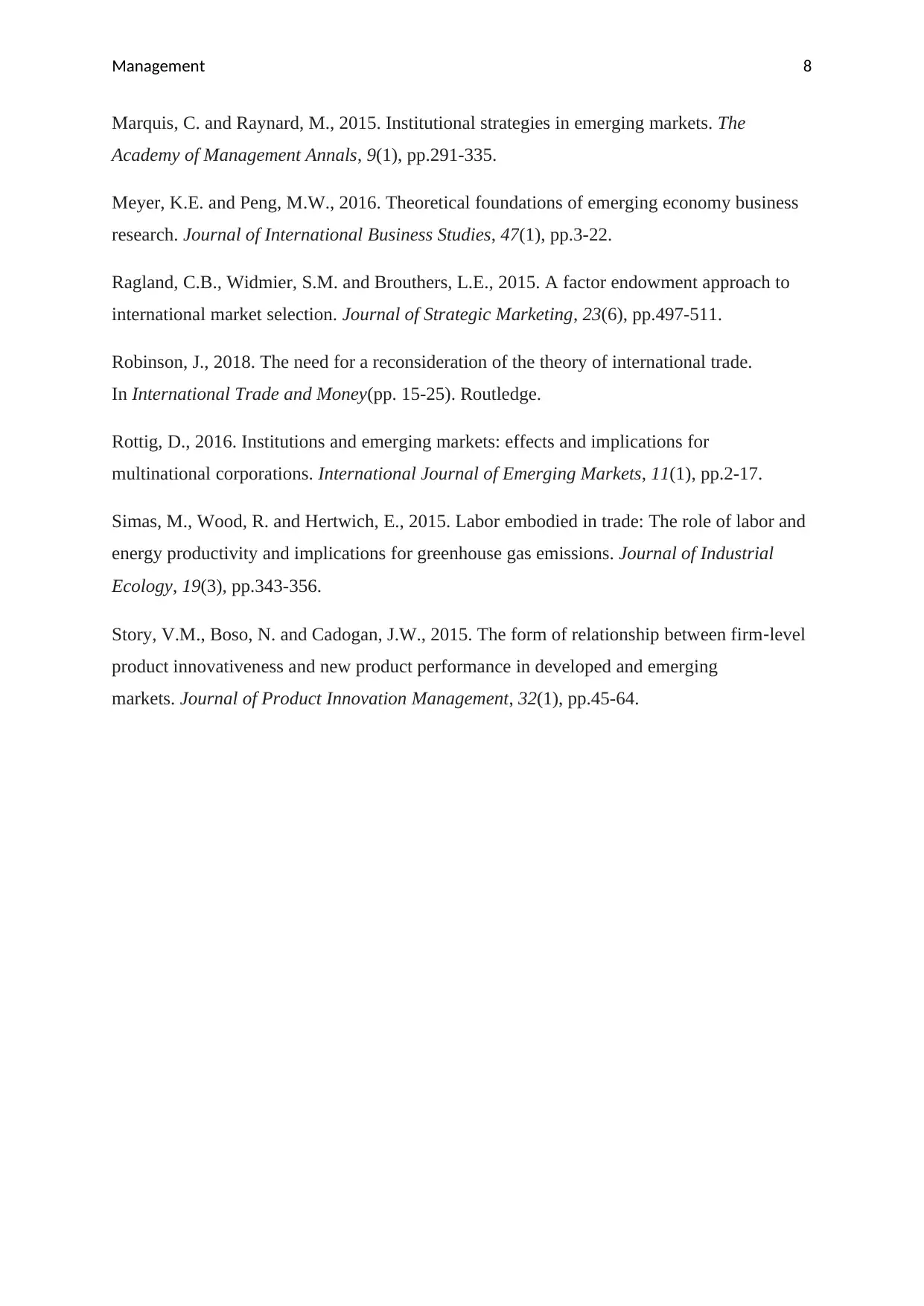
Management 8
Marquis, C. and Raynard, M., 2015. Institutional strategies in emerging markets. The
Academy of Management Annals, 9(1), pp.291-335.
Meyer, K.E. and Peng, M.W., 2016. Theoretical foundations of emerging economy business
research. Journal of International Business Studies, 47(1), pp.3-22.
Ragland, C.B., Widmier, S.M. and Brouthers, L.E., 2015. A factor endowment approach to
international market selection. Journal of Strategic Marketing, 23(6), pp.497-511.
Robinson, J., 2018. The need for a reconsideration of the theory of international trade.
In International Trade and Money(pp. 15-25). Routledge.
Rottig, D., 2016. Institutions and emerging markets: effects and implications for
multinational corporations. International Journal of Emerging Markets, 11(1), pp.2-17.
Simas, M., Wood, R. and Hertwich, E., 2015. Labor embodied in trade: The role of labor and
energy productivity and implications for greenhouse gas emissions. Journal of Industrial
Ecology, 19(3), pp.343-356.
Story, V.M., Boso, N. and Cadogan, J.W., 2015. The form of relationship between firm‐level
product innovativeness and new product performance in developed and emerging
markets. Journal of Product Innovation Management, 32(1), pp.45-64.
Marquis, C. and Raynard, M., 2015. Institutional strategies in emerging markets. The
Academy of Management Annals, 9(1), pp.291-335.
Meyer, K.E. and Peng, M.W., 2016. Theoretical foundations of emerging economy business
research. Journal of International Business Studies, 47(1), pp.3-22.
Ragland, C.B., Widmier, S.M. and Brouthers, L.E., 2015. A factor endowment approach to
international market selection. Journal of Strategic Marketing, 23(6), pp.497-511.
Robinson, J., 2018. The need for a reconsideration of the theory of international trade.
In International Trade and Money(pp. 15-25). Routledge.
Rottig, D., 2016. Institutions and emerging markets: effects and implications for
multinational corporations. International Journal of Emerging Markets, 11(1), pp.2-17.
Simas, M., Wood, R. and Hertwich, E., 2015. Labor embodied in trade: The role of labor and
energy productivity and implications for greenhouse gas emissions. Journal of Industrial
Ecology, 19(3), pp.343-356.
Story, V.M., Boso, N. and Cadogan, J.W., 2015. The form of relationship between firm‐level
product innovativeness and new product performance in developed and emerging
markets. Journal of Product Innovation Management, 32(1), pp.45-64.
⊘ This is a preview!⊘
Do you want full access?
Subscribe today to unlock all pages.

Trusted by 1+ million students worldwide
1 out of 9
Related Documents
Your All-in-One AI-Powered Toolkit for Academic Success.
+13062052269
info@desklib.com
Available 24*7 on WhatsApp / Email
![[object Object]](/_next/static/media/star-bottom.7253800d.svg)
Unlock your academic potential
Copyright © 2020–2025 A2Z Services. All Rights Reserved. Developed and managed by ZUCOL.





